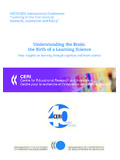Transcription of Measuring family socioeconomic status: An …
1 9 Measuring family socioeconomic status : An illustration using data from PIRLS 2006 Daniel H. Caro and Diego Cort sIEA Data Processing and Research Center, Hamburg, GermanyMany analyses of educational outcomes include a single socioeconomic status (SES) index as a predictor or for statistical control. In large-scale assessment research, these analyses have primarily examined the influence of SES on academic achievement in schools and the influence of other individual, family , and school variables when controlling for SES. The findings have helped elucidate the mechanisms underlying the influence of SES and identify possible avenues for reducing it. The measurement of SES is critically important with respect to the findings and implications of these analyses. This paper demonstrates a step-by-step procedure for calculating a family SES index using data from the Progress in International Reading Literacy Study (PIRLS) 2006.
2 Variables reflecting parental education, parental occupational status , and family wealth were reduced into a single SES index using principal component analysis (PCA). The conceptual definition of SES, its reliability and crossnational comparability are discussed, and recommendations for further research and survey developers are offered. The presented procedure can be extended to other large-scale studies of educational achievement. Its illustration is the main contribution of this paper. IERI Monograph Series: Issues and Methodologies in Large-Scale Assessments Volume 5 Copyright 2012 by Educational Testing Service and International Association for the Evaluation of Educational MONOGRAPH SERIES: ISSUES AND METHODOLOGIES IN LARGE-SCALE ASSESSMENTS VOLUME 5 INTRoDuCTIoNResearchers have studied the influence of family background on academic performance mainly in school settings (Sirin, 2005; White, 1982). Studies indicate that the performance of students from socioeconomically disadvantaged backgrounds tends to be worse than that of their peers from more affluent families.
3 Gaps between and across students from varying socioeconomic backgrounds tend to widen as students get older (Caro, McDonald, & Willms, 2009; Condron, 2007; Kerckhoff, 1993; Oakes, 1985) and have lasting consequences on the educational attainment and labor force outcomes of students as adults (Alexander, Entwisle, & Olson, 2007; Kerckhoff, Raudenbush, & Glennie, 2001; Raudenbush & Kasim, 1998; Rumberger, 2010).National and international student assessment studies offer a significant opportunity to study socioeconomic gaps in academic achievement between and within countries, and thereby to increase our understanding of how socioeconomic inequality reproduces across generations. Although some analyses have included separate variables representing concepts such as human capital, social capital, cultural capital, and economic capital, each postulated by a well-established theoretical model ( , Bourdieu, 1977, 1986; Coleman, 1988), others have employed a single variable to represent family socioeconomic status (SES).
4 family SES in this latter group of studies is typically defined as the relative position of an individual or family within a hierarchical social structure, based on their access to, or control over, wealth, prestige, and power (Mueller & Parcel, 1981). SES indexes are traditionally operationalized through measures characterizing parental educational levels, parental occupational prestige, and family wealth (Buchmann, 2002; Gottfried, 1985; Hauser, 1994; Schulz, 2005; Yang & Gustafsson, 2004). There is, however, no strong consensus on the conceptual meaning of SES, which limits its use for testing theories and making policy recommendations (Bornstein & Bradley, 2003; Deaton, 2002). Despite these limitations, many studies using the SES approach have made valuable contributions to educational Contributions of SeS StudiesThe many studies that have attested to the usefulness of including an SES index in analyses of student learning outcomes generally include an SES index for two main purposes (Buchmann, 2002): 1.
5 To gain an understanding of the extent to which and the mechanisms by which family SES is associated with academic achievement; and 2. To evaluate the influence of individual, family , school, and community aspects while controlling for regard to the first goal, Willms (2006a) proposed using socioeconomic gradients to examine the association between SES and academic achievement. socioeconomic gradients display, in single gradient lines, the strength of the association between SES and academic achievement, the association within schools, and the association across schools. Also, the functional form of socioeconomic gradients ( , linear or 11 Measuring family socioeconomic status curvilinear) indicates whether the SES gap widens, narrows, or remains stable as SES levels socioeconomic gradients helps us characterize the following: Achievement inequalities related to SES; How these inequalities relate to differences in family SES; Which aspect of the inequalities can be attributed to the SES composition of different schools; and The influence that the socioeconomic intake of schools has on achievement.
6 Analysis findings can also allow us to provide guidelines on the potential influence of different policy interventions (Willms, 2006a).Many studies, including the Programme for International Student Assessment (PISA), conducted by the Organisation for Economic Co-operation and Development (OECD), have adopted the socioeconomic gradient framework for studying educational inequality within and across countries ( , Caro & Mirazchiyski, 2012; OECD, 2003, 2004, 2007, 2010; Willms, 2002, 2003, 2006b; Willms, Smith, Zhang, & Tramonte, 2006; Willms & Somers, 2001). Also, in a recent article, Caro and Lenkeit (2012) showed how researchers can use international assessment data to extend this framework to include the analysis of sociological theories. Using data from the Progress in International Reading Literacy Study (PIRLS) 2006, carried out by the International Association for the Evaluation of Educational Achievement (IEA), the authors used two-level and three-level hierarchical linear models to evaluate 10 hypotheses about educational inequality within and across countries.
7 Researchers have examined other relevant aspects of the association between SES and academic achievement. These include studies of whether and how: This association changes over time (Heath & Clifford, 1990; Willms & Raudenbush, 1989); Is mediated and moderated by risk and protective factors (Chao & Willms, 2002; Guo & Harris, 2000; Yeung, Linver, & Brooks-Gunn, 2002); Is consistent across subject areas (Ma, 2000); Changes over the course of schooling (Caro & Lehmann, 2009; Caro, McDonald et al., 2009); and Helps to explain school grouping or tracking decisions (Caro, Lenkeit, Lehmann, & Schwippert, 2009; Condron, 2007; Maaz, Trautwein, L dtke, & Baumert, 2008; Schnabel, Alfeld, Eccles, K ller, & Baumert, 2002). Overall, these studies have provided us with a better understanding of the mechanisms behind the influence of SES on academic second goal of analyses including an SES index has been to control for SES differences when evaluating the influence of other variables on academic achievement.
8 For example, school effectiveness research controls for school SES in order to capture 12 IERI MONOGRAPH SERIES: ISSUES AND METHODOLOGIES IN LARGE-SCALE ASSESSMENTS VOLUME 5the effect of schools on academic achievement. Findings from school effectiveness research have helped identify school practices that affect student achievement positively irrespective of the socioeconomic composition of schools (Rutter & Maughan, 2002; Rutter, Maughan, Mortimore, & Ouston, 1979). Other applications include studying associations with migration background, social capital, cultural capital, and other family variables net of the effect of SES. Also, PISA (OECD, 2003, 2004, 2007) sets out league tables that rank countries according to overall student performance while controlling for SES. Such rankings take into account the varied socioeconomic conditions in which education systems operate and thus provide a fairer picture of relative PurposeOur main aim in this paper is to demonstrate the calculation and validation of an SES index, using data from PIRLS 2006.
9 Unlike in PISA, an SES index is not available in PIRLS and other studies managed by IEA. Another aim is to stimulate discussion on the possibilities for and the importance of calculating and providing an SES index in IEA datasets. Apart from the implications that our work has for IEA studies, we hope it will provide researchers with a detailed procedure that they can extend to other national and international assessment studies. Although we apply the traditional procedure for calculating SES, our approach is somewhat unusual on several counts. First, we employ coefficients other than the traditional Cronbach s alpha so as to offer a broader assessment of reliability. Second, we transform the job class classification scheme in PIRLS into an ordinal and internationally comparable occupational status scale. Third, we provide guidelines for SES assessment by placing the measurement of SES within literature on reflective and formative models.
10 And, fourth, we offer researchers and survey developers recommendations relating to SES validation and AND formative moDelSThe literature distinguishes between formative and reflective models for construct measurement (Bollen, 1989; Bollen & Lennox, 1991). These models differ mainly in their underlying assumptions of the causal relationship between the construct and its manifest indicators. In particular, three broad theoretical considerations are indicative of this type of model (Bollen & Lennox, 1991; Borsboom, Mellenbergh, & van Heerden, 2003; Edwards & Bagozzi, 2000; Jarvis, MacKenzie, & Podsakoff, 2003). These are:1. The nature of the construct ( , reflected or formed); 2. The direction of causality between the indicators and the construct ( , from the construct to the indicators, or vice versa); and 3. The characteristics of the indicators used to measure the construct ( , interchangeable or not).



